Towards a surface of information
It is no surprise that an orthodoxy of politically and socially conservative theories is quickly being promoted for digital media. The digital environment has become the talisman for economic and professional groups that are terrified of the continuing changes that effect them in the evolving global economy of information. Information designers are professionally and economically within this social context. There is a rush to create new theories (or apply old ones) regarding human cognition, factors testing, and other kinds of searches for 'hard data' that will help in arbitrating the new information environment as it continues to expand. Yet as we attempt to generalize new theories of communication from what are basically limited experiments or descriptive statistics, we may accidently repeat socially repressive patterns of behavior that had dire social consequences in the past that limited (often ethnically, often class-based)the inclusion of groups and individuals within society. With the partial acknowledgement of the limits of a positivist history of design, and a sense of the design 'solution' as being ambiguous or problematic in a changing cultural milieu, it has become clearer to most designers that graphic and information design is relativistic to the context that it is placed within. More importantly they have found it to be crucial. Is it still possible for designers to be culturally relevant in the evolving realm of digital and electronic media? At issue is how we define information and "the public", "the audience".
Within the hybridized electronic and digital environments of advertising and information design, prediction of the target audience is essential. Demographics1 helps to construct a sense of a typology of a targeted consumer. "Tailored" user (in information design) or consumer (in advertising) identities in effect recombine the language of cultural connotation. Advertising, now much broader in terms of its connection to electronic and digital information, involves the use of vernacular languages and individual desire, a combination which ties into the psychological construction of the individual to create a fetishistic relationship between consumer and product. Inextricably tied to capitalism, the format of the contemporary magazine or web page mixes information with consumption. In a sense information is no longer 'decoded' but consumed. The notion of multiple options for the reader and so-called freedom to enter a text has become appropriated and redirected. This is seen in the freedom of the consumer to affiliate with a unique and individual demographic typology mixing the advertising market of a particular magazine or web site with the construction of the individual through the stylistic information of the design. Within this new conception of information design, there are two socially problematic areas: 1)the modeling of behavior{whose behavior?}, and 2)the "message" as stylistic attribute{whose style?}. Each area carries significant implications within the electronic web where referral is consciously configured in external linkages of web sites; in other words, as the hierarchy and structure of the information design. Secondly, the conjoining of these 'radical' forms of typography and visual information may in fact be more socially repressive by the ability to hide institutions- virtually making them invisible by shifting the presentation of who they are to match consumer identities. This means that the new political and economic level of 'appropriation' of images and style (which in the nineteen-eighties was touted as a way of opening dialogue about institutional power2), is in fact, now focused on the audience. The marketing of products through the user's self-projection into digital information aids the institutional power of corporate and governmental entities to become invisible as a political identity and hence not socially accountable. While many cultural observers have decried the tyranny of the 'unseen author' of so-called objective information, which deny more than one cultural viewpoint, the digital environment may allow for a completely new form of the invisibility of institutional power through the issues of connotation/referral and digital navigation.
The control of information and the traditional designer
Traditional concepts of information design suggest a linear flow of communication and ideas from a sender to a receiver. The professional designer organizes and formulates methods, procedures and formal responses through this conduit of communication in print, creating and enforcing a series of rules and formal grammar that (in theory) insures that the audience has better comprehension, or in a sense, a higher 'fidelity' of reception of the original message. Additionally, many interface designers assume that the interface must make explicit the content of the application software- a form of written 'depth' that must be externalized, a form of anthropomorphism that recalls the microcomputer-as-robot; as a double of the human, an alternative psyche3.
This uncriticizable "aura" of the computer is enhanced when theories about the innate ability of the user are "proven" through the reduction of basic utilitarian functions to statistical methods, thus completing a cycle that closes off social critique of the digital environment.
It is questionable now whether these methodologies are applicable owing to the electronic web of information. Linear communication is overwhelmed by electronic information which combines and hybridizes what were once considered discrete and definable ideas of the 'sender' and the 'receiver' of a message.
The electronic environment involves ordering events which combine sound, moving images and gestures which are understandable to users through their experience of information as an event and as interaction. With the waning of discrete authors or 'senders' who have control over content and form; images, sounds and narrative fragments exist as connotation and association.Rather than the similarities of language and audience, cultural differences are the new locus of meanings created within or between groups. Representation in electronic and digital information creates collisions and fusions of multiple meanings throughout the entire mass-audience, which cannot be predicted based on the unitary, though atomized 'values and lifestyles' demographic models.
If we think of the computer as a medium rather than as an 'interiorization' of abstract processes, then the computerÕs 'depth' or 'interior' becomes an exterior: a node or fold on a surface of the languages that it mediates. Interconnectivity and the microcomputer therefore become primarily an issue of users within communities rather than the means of reductive symbols or functional tasks. If the computer may be rethought as part of a larger social phenomenon, interconnectivity becomes a surface of information and meaning, and how we define interconnection is essential.
Thinking about the microcomputer and design activities in general as 'interconnection' to a larger pattern of daily use denies the mythologies of innovation by specialists alone.
a call for social pragmatism
The surface of information at this point must now be redescribed as a geography- as a geo-political map where users and groups affiliate, ally or come into conflict based on language. A culturally universal and standardized language, and its relationship to a centralized authority to enforce its usage is weakened within this environment. The phenomenon of lateralization and segmentation between cultural groups will increase owing to the nature of the digital environment to lateralize transmission and reception from a central state authority to a diffusive corporate authority.
By judging contemporary culture only on the past criteria of written culture will inevitably see the new social environment as a culture in ruins which must be reclaimed (the new 'empirical' information design of digital media), or as a form of cynical utopian fantasy and escape (the 'avant-garde' of electronic media).
Other positions are possible. The social environment, which is now indistinguishable from the surface of information is a site to reclaim as part of the discourse of the design of electronic information. In this massive artificial space which does not give us a visual and spatial understanding as in the landscapes of the physical map, or the "memory palaces" of Frances Yates, the crisis is not one of a belief in written culture or electronic cultures but of visibilities; the ability to visualize or image complex social relationships that the electronic environment tends to make invisible with its emphasis on the user and his or her self-projections into information.
The most crucial question is whether the user will be allowed to understand their relationship to knowledge or whether they will be denied this understanding by the 'naturalized' discourse of institutions. Without an orientation to the geography of the new social environment, the user may be lost, yet be quite capable of performing a task which makes a complete abstraction of his or her labor. The idea that information is an involvement within culture, where the rules or conventions of languages are part of the construction by the audience, may be illustrated through many examples.
The following examples are important in showing the transitions and evolution of electronic information.
Evolution of the image
Monuments are constructed with the intention of cultural unity. Unlike examples often used from popular culture which tend to be based on community identity within a larger (and often hostile) 'mainstream' culture, contemporary ideas of the monument are powerful ideological sites (even though ultimately ambiguous),which counter the truism that all contemporary post-modern messages are forms of ironic parody. These environments, intended to serve as historical memory are utilized intuitively by 'users' and participants as part of the electronic 'surface of information'.
Dealey Plaza, Dallas Texas, 1963 and 1998
The physical space of Dealey Plaza is still relevant after thirty-five years because it is a site of participation through electronic distribution. In terms of a kind of history of representation it is one of the most indelible 'historical anecdotes' first understood through time-based media. The most significant images remain the the hand-held home movie camera images taken by Zapruder and first printed in Life magazine immediately after the assassination. Significant images continue to be recreated through still and moving images which include the scope-sightings of OswaldÕs gun and the optional position of the grassy knoll. What has replaced the 'reading of history' is the concept of enactment.
A spectator in the actual environment attempts to recall the event through a technologically mediated memory of the framing of images; essentially the historical characters are understood as virtual positions through the positioning of the original camera or the viewpoint of bystanders and participants. Simultaneously, concepts of time change in the space, from written narrative's chronological placement in a larger history, to film or video-camera sequence. Placing oneself in the narrative(s) is accomplished through the recording of moments that are significant based on the videographer's perceptual scan in the space; literally the images and fragments of gestures caught by the lens and microphone are placed chronologically as a series of events held together by the video-tape time-index. The spectator recording his or her movement within the space creates a translation of the spectacle through his or her unique and past experiences of the electronically mediated images of the event.
The technology of the moving image annihilates the past and the future, as well as distance: sound and moving image emphasize the present as experience and participation. The original and most well-known images of the event are dateable (in the same sense as a video camera time-index) but not part of an authoritative historical narrative: the moving image is always activated and in the present with the viewer. The structure of electronic narrative opens out into a cultural space that can no longer support closure, rather, cycles of narrative are re-enacted through electronically mediated user narrative in film, television, and computer, sometimes to the point of cultural obsession.
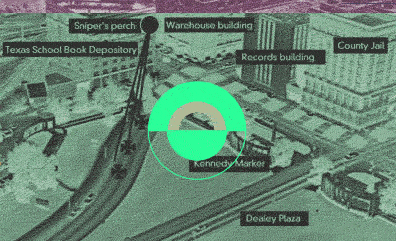 The Mall, Washington D.C. 1998
The Mall, Washington D.C. 1998
As a later example of the 'evolution of the image', translation within the space of the Vietnam Memorial is dependent on the participant/spectator's associative knowledge of events surrounding the Vietnam War. As an actual space it is neutral- no actual historical event occurred on it's site related to the event that it conveys, as in Dealey Plaza. The 'Wall' functions primarily as a dis-embodied image; where the audiences relationship to the image is primary, and the physical space itself is secondary as a stage set or backdrop.
Representation is completely dependent on the apparent position of the viewer/participant: the photographic gaze and memories of images are institutionalized as legitimate historical understanding. The interpretation of the actual space depends on electronic media as the primary place for the historical monument. The components of the space deny traditional written narrative which is alluded to in earlier monuments.
To create a shared historical symbol of the conflict is not dependent on a figurative sculpture (even though one has been placed adjacent to the space) or a particular historical moment (such as a battle or famous figure identified with the conflict) which would be seen as a significant climax in a linear narrative of history. Rather, the historical sense of the conflict occurs through remembered visual and narrative fragments of film and television, which may be photo-journalistic, documentary, cinematic- or more recent television reportage that is actually situated at the wall. Writing is emptied of metaphor and symbol and functions in the space as metonymy- to find one's place in the quantity of information is the primary activity of reading within the space. Resisting the single-author narrative of a text-based history, the list of American war dead functions as index. Park workers help viewers to find their 'place in the indice' by culling through printed lists that are similar to telephone books; they function in a sense as information specialists. The writing within the space lacks traditional concepts of what is 'literate': conspicuously absent is any historical narrative that explains or justifies the role of the war or itÕs relationship to United State's history as 'another chapter' in a larger progressive history. As the spectator views the space as an entirety, the typography as an image helps to deflate traditional authorship and historical narrative. It becomes instead the image of the names which connotatively mimic the rolling end credits of television and the mounting death toll appears as a cinematic sequence. The absent historical text that would traditionally provide closure for the viewer is displaced in favor of the viewer's construction of an identity for the dead through whatever indexical clues are present- the apparent ethnicity of a surname, the connection to family members or others present, or objects left near the recorded name which opens up the possibilities of an extended narrative.
The electronic tool of the video camera in the hands of the user completes the exchange. The ability to mix production and reception by the act of recording, to make meaning through the individual at the site, is an action of dialogue between personal memories and public images; to splice home video with what has become a mixture of personal narrative fragments and other portrayals of the subject through advertising, film and television etc. The viewer takes on a partial role of the characters of network broadcast. The videographer seeks out the camera angle as a way of containing and legitimizing the scene that he or she recreates and mimics: if they appear close to the framing of the public images of grief from network broadcast then they are more valid as an appropriate display of public emotion.
As with other media which are extremely image- and time- dependent, the micro-computer and the Graphic User Interface pioneered by Xerox and incorporated into the majority of personal computers is the most recent form of technological synthesis of the experience of electronic interpretation, built on our exchanges as authors and interpreters of experiential information. The Graphic User Interface as another form of 'point-of-view technology', shares similarities with the basic controls of position and editing which include modulation, selection, and framing of raw visual and other data. Modulation changes intensities; selection distinguishes parts from the whole; while framing changes the viewer's apparent proximity to the information through changing position within a selection, scrolling, enlarging, or moving within a computer screen that shares more similarities between the vertical and horizontal divisions and primary figurative compositions of the broadcast television screen than the printed page.
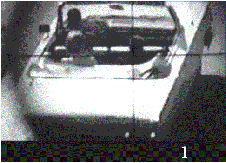
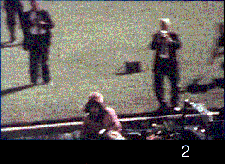
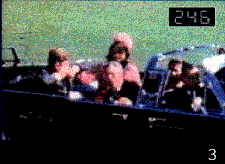
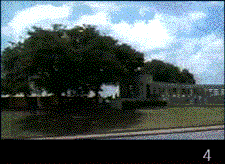 At a time when interest in cultural investigation is waning in certain fields such as Graphic Design, where (ironically) intellectual fashions have shifted, it is more essential than ever to bring social and cultural scrutiny to bear on the issues of interconnection and the electronic environment. A series of critical practices that illuminate the social product of information in communities that are inherently different is essential rather than a single reductive answer of brain physiology or statistical testing.
At a time when interest in cultural investigation is waning in certain fields such as Graphic Design, where (ironically) intellectual fashions have shifted, it is more essential than ever to bring social and cultural scrutiny to bear on the issues of interconnection and the electronic environment. A series of critical practices that illuminate the social product of information in communities that are inherently different is essential rather than a single reductive answer of brain physiology or statistical testing.
Theories implied but never proven by contestable experimental data and testing have created social discrimination in the past when it has been reified and applied to business, educational and governmental policies.4 The issues of visibility and open discourse through socially pragmatic design is important to the creation of a social space that is usable to all rather than the privilege of a few.Our design activities could become the augmentation of the 'point-of-view' of information events rather than managing data. The evolution of the 'point-of-view' aspect of the image can be further defined as a Ôpoint-of-viewÕ prosthetic; in other words a redefinition of 'information design' as a prosthetic for a user rather than the traditional control of an infrastructure or system of information. Information design could then become a social extension of visualization- where aiding differences in outlook and language would become a series of 'niche markets' rather than a totalizing design based in a single universal system of language and values.
What Brenda Laurel and others refer to as 'creative agents'3 are, when the interface is inverted as a point on the social surface of information, the self projections of the user, the simulacrum created by the indexical systems of representation that the computer fosters. On the simplest level what is at stake is the understanding that this is a cultural product and that the user should have knowledge about his or her relationship in the construction in order to take back some measure of power in the new spaces of society.
1) see Schwartz, Peter, The Emergent Paradigm: changing patterns of thought and belief, SRI International, 1983.
2) many examples exist that use the idea of appropriation as cultural resistance, for example see Owens, C. The Discourse of Others: Feminists and Postmodernism. The Anti-Aesthetic, Essays on Postmodernism, Hal Foster (ed.)1983, Bay Press
3) see Laurel, B. Computers as Theatre. Addison Wesley, 1993 pages 12-13.
4) Recent historical examples include the development of diagnostic educational testing by Alfred Binnet at the turn of the century which was appropriated and modified as the 'I.Q.' test. The concept of natural or 'inborn' intelligence was subsequently used in the United States to cull immigrants and others who did not speak English. see Binet,A.;and Simon,Th.1911 A method of measuring the development of the intelligence of young children. Lincoln, Illinois: Courier Company, 83pp. 1912. and Yerkes, R.M. (ed.) 1921. Psychological examining in the United States army. Memoirs of the National Academy of Sciences, vol.15, 890 pp.
